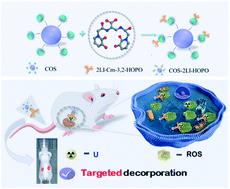当前位置:
X-MOL 学术
›
Environ. Sci.: Nano
›
论文详情
Our official English website, www.x-mol.net, welcomes your feedback! (Note: you will need to create a separate account there.)
Decorporation of uranyl in kidneys using an engineered nanocomposite
Environmental Science: Nano ( IF 7.3 ) Pub Date : 2022-06-24 , DOI: 10.1039/d2en00133k Cen Shi 1 , Xiaomei Wang 1 , Qiwen Sun 1 , Lei Chen 1 , Jingwen Guan 1 , Linwei He 1 , Yijing Zhang 1 , Yujie Xu 1 , Jianping Cao 1 , Zhifang Chai 1 , Shuao Wang 1 , Juan Diwu 1
Environmental Science: Nano ( IF 7.3 ) Pub Date : 2022-06-24 , DOI: 10.1039/d2en00133k Cen Shi 1 , Xiaomei Wang 1 , Qiwen Sun 1 , Lei Chen 1 , Jingwen Guan 1 , Linwei He 1 , Yijing Zhang 1 , Yujie Xu 1 , Jianping Cao 1 , Zhifang Chai 1 , Shuao Wang 1 , Juan Diwu 1
Affiliation

|
Internal exposure to uranium, a well-recognized nuclear material poses a health risk to the public, especially in contamination zones. However, the fast excretion and non-target distribution of most molecular decorporation ligands greatly reduce the decorporation efficacy, and frequent administrations are often required. To make matters worse, the clinical application of many molecular decorporation agents is restrained due to their high toxicity. Herein, we synthesized a carboxyl functionalized tetradentate hydroxypyridinone (HOPO) ligand and attached it onto chitosan oligosaccharide (COS) nanoparticles via amidation to yield a COS-2LI-HOPO composite. The biodistribution and pharmacokinetic studies verify the long-term accumulation of COS-2LI-HOPO in the kidneys, which is beneficial to the removal of uranium. Besides, the cytotoxicity of the material is much lower than the HOPO ligands. In addition, the uranium decorporation efficacy is up to 54.8% and 35.2% for the kidneys with prophylactic and delayed administration, respectively. Moreover, the composite is recognized to be able to reduce the cellular ROS amount to the same level as the blank control group due to the synergistic ROS scavenging effect of COS and HOPO moieties. Our current results reveal the fabrication of a nanocomposite by the modification of a chelating agent onto COS is effective in reducing toxicity, regulating ROS, and achieving kidney oriented decorporation of uranyl.
中文翻译:

使用工程纳米复合材料去除肾脏中的铀酰
铀的内部暴露是一种公认的核材料,对公众构成健康风险,尤其是在污染区。然而,大多数分子解构配体的快速排泄和非靶向分布大大降低了解构效力,并且经常需要频繁给药。更糟糕的是,许多分子剥离剂的临床应用由于其高毒性而受到限制。在此,我们合成了一种羧基功能化的四齿羟基吡啶酮 (HOPO) 配体,并将其连接到壳寡糖 (COS) 纳米颗粒上。酰胺化得到 COS-2LI-HOPO 复合材料。生物分布和药代动力学研究证实了COS-2LI-HOPO在肾脏中的长期蓄积,有利于铀的去除。此外,该材料的细胞毒性远低于HOPO配体。此外,预防性给药和延迟给药对肾脏的铀去除率分别高达54.8%和35.2%。此外,由于 COS 和 HOPO 部分的协同 ROS 清除作用,该复合材料被认为能够将细胞 ROS 量降低到与空白对照组相同的水平。我们目前的研究结果表明,通过在 COS 上修饰螯合剂来制备纳米复合材料可有效降低毒性、调节 ROS 并实现铀酰的肾脏定向脱附。
更新日期:2022-06-24
中文翻译:

使用工程纳米复合材料去除肾脏中的铀酰
铀的内部暴露是一种公认的核材料,对公众构成健康风险,尤其是在污染区。然而,大多数分子解构配体的快速排泄和非靶向分布大大降低了解构效力,并且经常需要频繁给药。更糟糕的是,许多分子剥离剂的临床应用由于其高毒性而受到限制。在此,我们合成了一种羧基功能化的四齿羟基吡啶酮 (HOPO) 配体,并将其连接到壳寡糖 (COS) 纳米颗粒上。酰胺化得到 COS-2LI-HOPO 复合材料。生物分布和药代动力学研究证实了COS-2LI-HOPO在肾脏中的长期蓄积,有利于铀的去除。此外,该材料的细胞毒性远低于HOPO配体。此外,预防性给药和延迟给药对肾脏的铀去除率分别高达54.8%和35.2%。此外,由于 COS 和 HOPO 部分的协同 ROS 清除作用,该复合材料被认为能够将细胞 ROS 量降低到与空白对照组相同的水平。我们目前的研究结果表明,通过在 COS 上修饰螯合剂来制备纳米复合材料可有效降低毒性、调节 ROS 并实现铀酰的肾脏定向脱附。



























 京公网安备 11010802027423号
京公网安备 11010802027423号